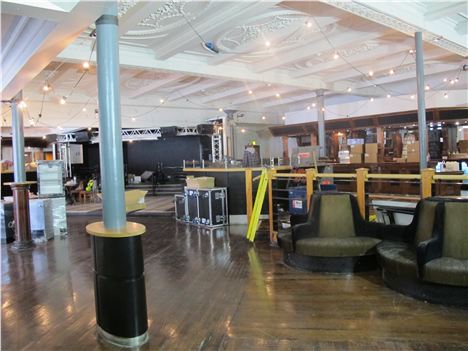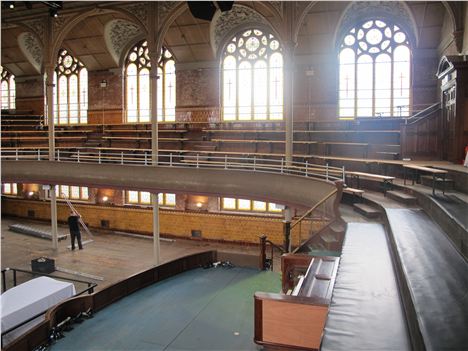THIS is how Manchester works.
Walking past Peter Street’s Albert Hall to review new halal steakhouse Rump’n’Ribs I hear my name being called.
Of course there will be live music but I have to take advantage of the way this place looks, the quality of the light that comes through the windows, the heritage of the venue.
Councillor Joan Davies, city centre councillor, top class theatre reviewer for Confidential and general good egg, is chatting to a man with a beard I can’t place. She introduces him.
The man turns out to be one of the entrepreneur extraordinaires of Manchester's gig and bar scene, Joel Wilkinson.
Wilkinson has given the city six well-known venues including Trof, Deaf Institute, Gorilla and now most ambitiously of all – some might say craziest of all – he’s embarked on a very expensive revitalisation of Albert Hall, the gargantuan, former Methodist meeting hall on Peter Street.
This was designed in 1910 by WJ Morley of Bradford, in an eclectic mix of Gothic with mad Baroque detailing. Probably Morley’s proudest moment was when he had a premonition that after the teetotal Manchester and Salford Wesleyan Mission had moved out it would become Brannigans, a bar so drunken and far removed from temperance Blue Wicked was used as mouthwash...by the cleaners.
Big blousy balconies
Wilkinson kindly offers to give me a tour.
"So what will the space be called?" I ask.
“The Albert Hall,” he says. "That's what it's always been called."
“Won’t there be a rights issue with that name?”
“The other one’s the Royal Albert Hall, so we should be ok,” Wilkinson says.
“And how many people can the place fit?”
“Just the balcony area in the main hall here can fit 790, the lower section can fit 1,500 standing. With the former Brannigans space on the ground floor that takes us to around 2,500,” says Wilkinson.
“Doesn’t that give you sleepless nights?” I say. “It puts you bang in competition with O2 Apollo, Academy 1, the Bridgewater Hall, venues between 1,500 and 3,500 capacities. Is there enough audience to go round?”
“I’ve had sleepless nights for years now, I have four kids,” Wilkinson quips. “But this will be much more than a concert venue. Of course there will be live music but I have to take advantage of the way this place looks, the quality of the light that comes through the windows, the heritage of the venue. It's a special space. So we’ll also be letting it for conferences, award ceremonies, seminars, exhibitions, weddings. It will be constantly worked.”
He's right. The light quality is extraordinary.
Venues of this scale rarely have windows, let alone double-height windows with stained glass details. In the early afternoon as we sit on the bench seating in the gallery of the main auditorium, the already bright space is suddenly brilliant with sunshine.
The cleverly slender cast-iron columns supporting the roof allows the light to fill every nook and cranny. It's uplifting.
Of course, there will be blinds on the windows for night time events.
Huge organ
Aside from the windows, rarely do venues have a fitted organ as big as the one in Albert Hall.
Does it work?
“We’ve had it fixed,” says Wilkinson. “It’s loud, but again adds another dimension to the venue. Makes it more adaptable.”
The organ in Albert Hall was famous for its volume and richness back in the Methodist days. It's mighty blast almost made pious Non-Conformists singing for God, chastity and sobriety understand the meaning of ‘make the Earth move’.
“It's features such as the organ that’s part of the attraction of the place,” continues Wilkinson. “The stage will hold a 25 piece orchestra for Goldfrapp during Manchester International Festival (MIF), indeed we’ve already had interest from the Royal Northern College of Music and Manchester Camerata.”
“When will you be opening the place?” I ask.
“We open on two floors for MIF starting later this week, they’re holding a number of events here. Being associated with something as prestigious as the Festival is great publicity for us, puts our name across the world. Then we close again, make final changes, but we have to be open by February 2014. We need to have the paying public in by that date.”
At Brannigans you could get completely get plastered but not as winsomely as this
“And the old Brannigan’s space downstairs, what’s going in there?”
“A bar, restaurant, performance space too. Smaller obviously. The menu will be like Gorilla’s (a chic take on Brit-Americana – see our Gorilla review here) but one that can cope with people using the bar as a warm-up place for the main hall. It will open regular bar hours.”
The former Brannigans
We take a tour of the gallery to allow me to take pics from one of the corners, across the dramatic space to the organ.
“According to TV series Most Haunted, Derek Acora encountered a spook in here,” I say. “Have you seen any ghosts?”
Wilkinson shakes his head, “Nothing. And my brother and I have crawled through every space and roof-loft in the building. We've been in all the dark bits, but there's been no ghosts.”
He pauses.
“Actually you can maybe help me out. I’ve been trying to discover how the air was circulated in the original building. I know how they drew the fresh air in but not how it was pushed around the building and released out again. I've talked to the Victorian Society and everybody else I can think of but they don't know. Could you ask your readers for help? Maybe someone out there has the knowledge?”
“So that’s why you were crawling around in the muck.”
“Exactly.”
We walk back down to the entrance.
“What drove you to become a venue entrepreneur?” I ask, passing the time.
Wilkinson dressed casually with a blue denim shirt and a voguishly unruly beard - looking the exact opposite of a sharp-suited businessman - says, “I left school without qualifications I had to do something. I have to provide for my family.”
He's being serious I think.
“How old are you?” I ask, like any hackneyed old hack should.
“Forty five,” he says with a laugh. Wilkinson is a famously private person - he won't let me take his picture - so even this fact seems a concession.
“Is Albert Hall as far as you can take the Trof empire?” I ask.
“Not at all,” he says. “I reckon I’m five years behind where I want to be?”
Another tiled building of Manchester needing attention crosses my mind.
“In that case, what about London Road Fire Station?” I say, referring to the biggest semi-derelict property in the city, mismanaged by the Britannia Group since the eighties.
“I've been round it,” says Wilkinson. “Didn’t fancy it. Didn’t think it would work for us.”
“Have you ever thought of running a Trof hotel?" I say, fishing. "Maybe something boutique style, very distinctive but big with a large courtyard?”
Wilkinson’s eyes light up, “I have thought about hotels, and that place does have a courtyard? I’d like to have a place with a courtyard...”
He gazes misty-eyed into the middle distance.
We're lucky to have people like Wilkinson in Manchester.
Think of how many venues of this scale - 2,500 capacity - are renewed and run by what is effectively a small local company.
The answer is none.
Wilkinson will be the first to admit that he's had plenty of help along the way from many organisations and agencies.
Of course he has.
But all these projects, especially ones on the scale of Albert Hall, need someone to have the dream and then the capacity to deliver on that dream.
Everytime the Trof chain has gained a new site it seems to have gone forwards, each venue more interesting than the last. This follows the pattern and then some. Albert Hall is an event scene game-changer, a mix of scale, good looks and charm.
By the way Rump'n'Ribs doesn't open until 5pm. I missed out on steak but I got Albert Hall instead.
I'm not complaining.
Nice curves
You can follow Jonathan Schofield on Twitter here @JonathSchofield or connect via Google+
















